A Comprehensive Guide to Purchasing Aggressive Inline Skates

Aggressive skating is fundamentally about artistic expression and innovation. Your choice of aggressive skates is crucial for an enjoyable blading experience. Here, we provide numerous valuable tips and guidelines for those purchasing new aggressive inline skates.
Overview
Overview
Guidelines for Sizing Aggressive Inline Skates
When determining the size for aggressive skates, it's crucial to avoid selecting a model solely based on your shoe size. Instead, use a tape measure to ascertain the exact length of your longest foot.
With an accurate foot measurement, finding the appropriate size becomes straightforward. Each model of aggressive skates on our homepage includes a size guide to assist you in selecting the right size, relying on your foot's length. These size guides follow the Mondopoint-system and use millimetres for easy conversion between sizes.
Steps for Measuring Your Foot

- Stand on a sturdy, level surface.
- Wear the socks intended for skating.
- Place a piece of paper flat against the wall.
- Stand with your heel touching the wall, ensuring your foot is flat on the paper.
- Mark the paper at the tip of your longest toe.
- Measure from the wall or paper edge to your marking.
- Repeat the process for both feet and use the longest measurement for choosing your skate size.
Ideal Fit for Aggressive Skates
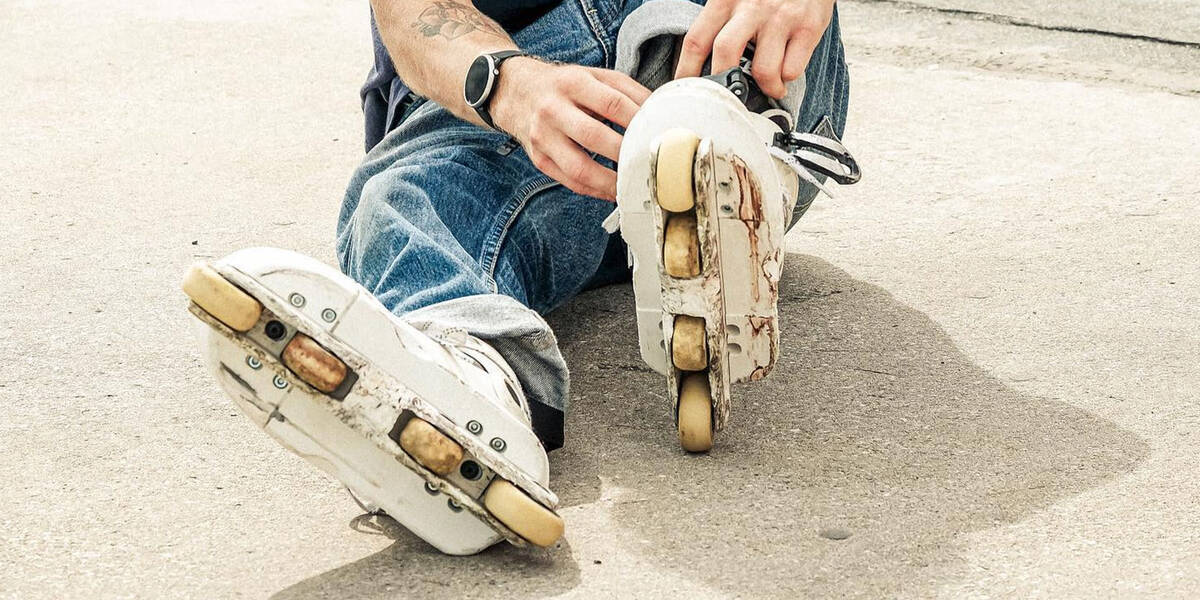
For optimal control during stunts, aggressive skates should fit snugly around your foot. Excess space inside the trick skates may cause your feet to slide within the boot, resulting in blisters and decreased control. Bigger skates can be heavier, complicating tricks.
In essence: Aim for a snug fit that doesn't cramp your feet or toes for optimal performance.
Breaking-In Process for Aggressive Skates
New aggressive skates might need a period to become truly comfortable. Remember, they should fit snugly, with the liner adapting to your foot's shape over time.
Here are some break-in tips for aggressive skates:
- Wear thick socks to minimize friction and prevent blisters.
- Break in the skates by wearing them while engaging in other activities.
- Begin with shorter sessions and extend them progressively.
- Ensure laces and buckles are tightly secured for a comfortable fit.
One advantage of aggressive skates is the ability to replace worn-out liners with new ones.
Understanding the Anatomy of Aggressive Skates

- Boot: Aggressive skates are equipped with hard boots or shells.
- Frame: Sturdy frames designed to endure grinding and harsh landings.
- Wheels: Small wheels prioritise stability and control.
- Soul plate: Imparts a broader range of grinding techniques.
- H-block: Designed to facilitate grinding.
Aggressive skates are crafted specifically for tricks, grinds, and jumps, both in urban settings and skateparks, transforming a variety of obstacles into opportunities for new tricks and explorations. Among skates designed for grinding, aggressive skates are unparalleled.
Equipped with smaller wheels than other inline skates, aggressive skates lower the centre of gravity, enhancing control. This makes them more agile and manoeuvrable, ideal for a broad spectrum of tricks. These features make them excellent for trick-performing, but if commuting, long-distance skating, fast-paced city skating, or fitness-oriented skating is your focus, skates with larger wheels are advisable.
Selecting Aggressive Skate Wheels

Essential attributes of aggressive wheels include diameter, hardness, and profile. These greatly influence your skating experience.
Fine-tuning each of these elements can align with your style and most commonly encountered terrain, optimizing the performance of your aggressive skates.
Diameter Specifications for Aggressive Skate Wheels
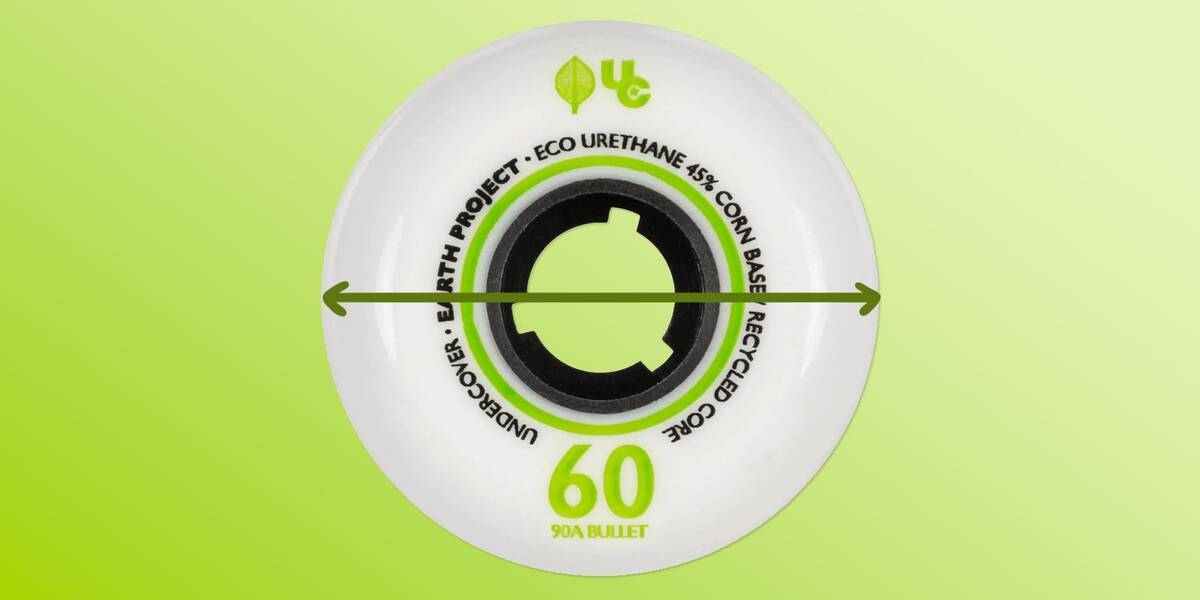
The standard wheel diameter for aggressive skates ranges between 56-60 mm but can vary from 54 to 80 mm.
- Larger wheels (60-80 mm): Offer more speed but less stability, adding difficulty to technical tricks.
- Smaller wheels (56-58 mm): Provide more stability but are slower.
For aggressive skates with generally sized wheels, choose a model featuring 58 or 60 mm wheels.
Profile Types for Aggressive Skate Wheels

Aggressive inline wheels typically have a flat profile, though some might be more rounded or pointed.
- Flat profile: Stable and easy for trick landings.
- Rounded profile: Increases agility with less grip, reducing wheel-bite risks on rails.
- Pointed profile: Faster, easier turns due to less friction (not common in aggressive skating).
For trick-heavy aggressive skating, flat profile wheels are often recommended, though for added agility and speed, a rounder profile may be considered.
Understanding Wheel Hardness in Aggressive Skates
Aggressive skate wheel hardness is determined by the durometer scale, typically ranging from 86A to 95A. A higher durometer indicates harder wheels.
- Harder wheels: They roll faster on smooth surfaces but absorb less vibration, making uneven surfaces more troublesome. Easier sliding with less wheel bite during grinds.
- Softer wheels: Offer more stability, better vibration absorption, and enhanced grip.
Balance the advantages and disadvantages of harder versus softer wheels on aggressive skates against your personal preferences and skating style.
Different Wheel Configurations in Aggressive Skates
Aggressive skates are available with either a flat wheel or an anti-rocker wheel setup. These terms describe the line formed by tracing the underside of the mounted wheels. Wheel configuration greatly influences the ride, making it a vital consideration when selecting new aggressive inline skates.
An In-Depth Look at Anti-Rocker Setups
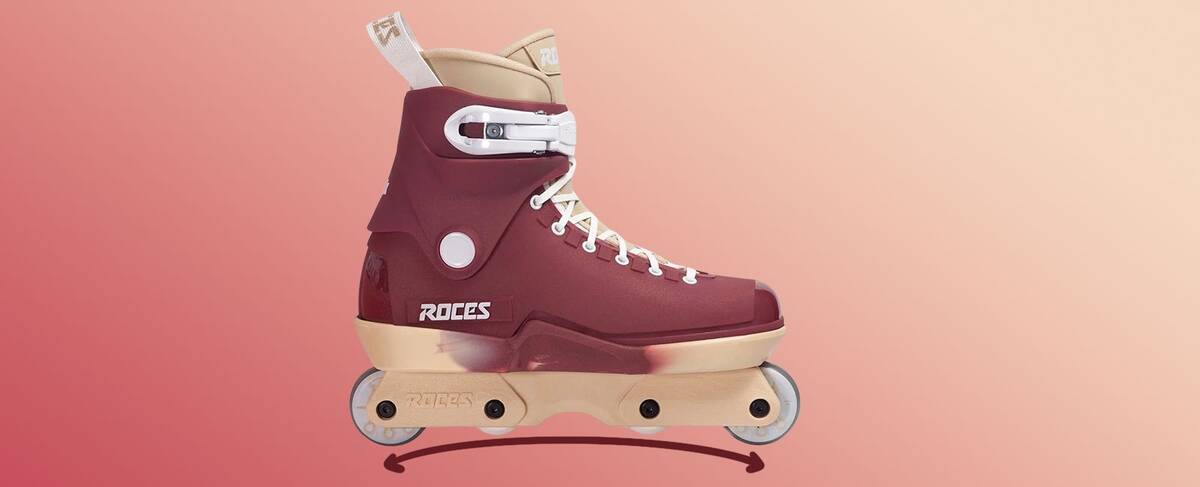
Anti-rocker configurations incorporate larger front and back wheels, with smaller middle wheels to facilitate grinding. These setups turn less easily than flat configurations, forming two points of contact which complicates turning compared to flat or rocker setups. If the rigidity of an anti-rocker setup is a deterrent but you still wish to focus on grinds and aggressive skating, consider opting for a flat wheel configuration.
Understanding Anti-Rocker Wheels
Anti-rocker wheels are the two central wheels in aggressive inline skates featuring an anti-rocker arrangement. They are smaller and significantly harder than the outer wheels and don't contact the ground during rolling. Their purpose is to minimise interference with your grinds while aiding in locking into various grind types. Typically composed of a hard PU formula to avoid sticking to rails.
Anti-rocker wheels are named for their smaller size, creating an upward groove between the ground and wheel bottoms, unlike a rocker setup where the outer wheels are slightly smaller to encourage a rocking motion.
Do Anti-Rocker Wheels Need Bearings?
Bearing installation in anti-rocker wheels can be beneficial for actions such as stairbashing, enabling the wheels to roll smoothly down stairs. Often referred to as grind wheels, their primary role in aggressive skates is to prevent sticking during H-block grinds, making bearings unnecessary. Some come equipped with bearings, while others don’t.
Explaining Flat Setup on Aggressive Skates
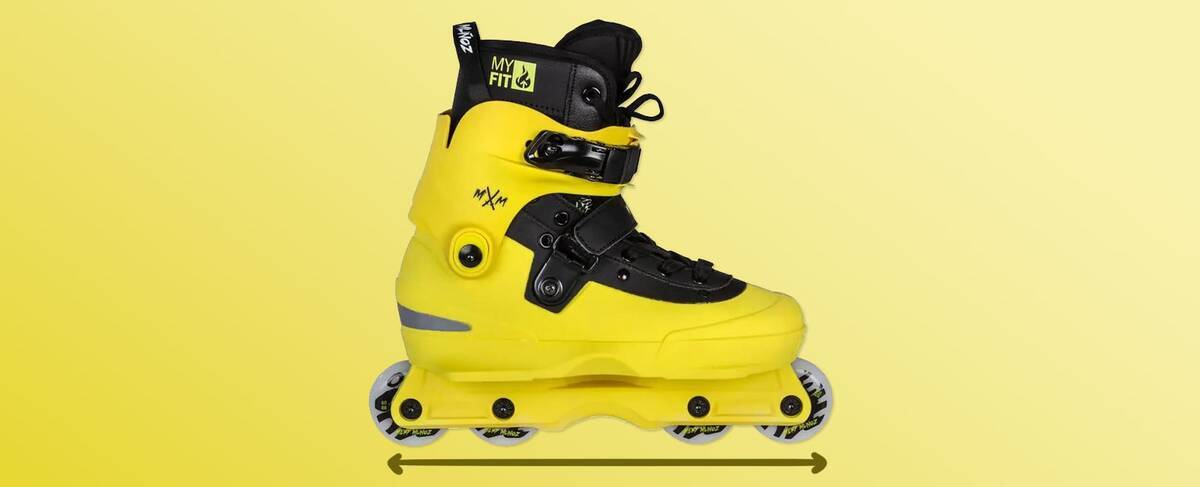
In flat configurations, all four wheels maintain the same size, boosting rolling speed and manoeuvrability compared to anti-rocker setups. Flat setups demand higher precision for groove grinds due to increased slamming risk if the middle wheels stick to rails. Not all frames can accommodate flat configurations due to the space needed for middle wheels.
If you’re a novice to inline skating with a focus on aggressive skating, a flat setup is a strongly recommended choice. Many advanced aggressive skaters favour flat setups for their style and challenge, necessitating precision for grinding on H-blocks.
Comparing Flat and Anti-Rocker Setups
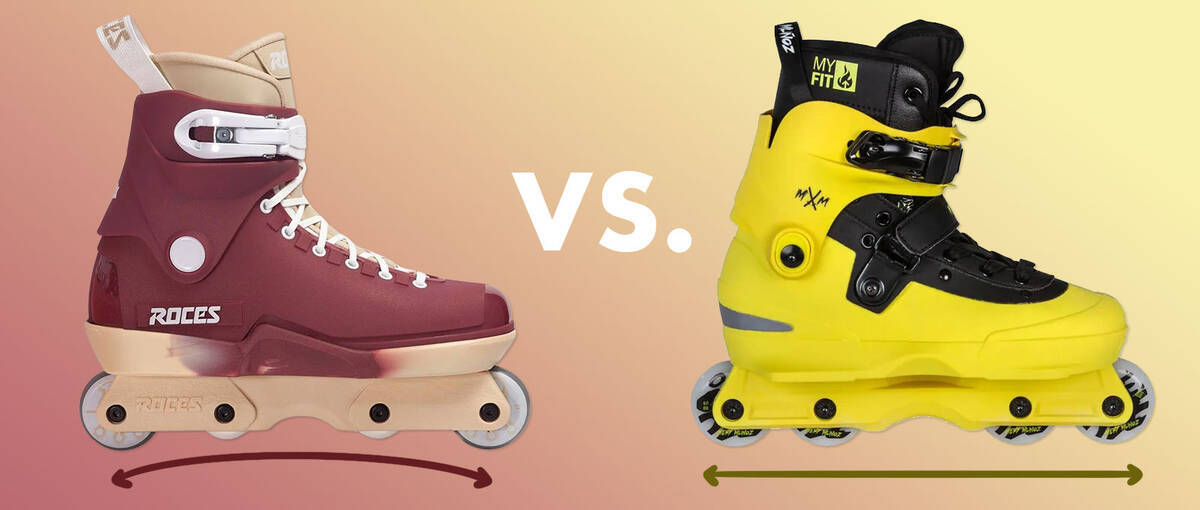
Regardless of your experience level, choosing between a flat or anti-rocker setup boils down to personal preference. Neither is inherently superior.
Consider these points if you're uncertain about which setup to choose while purchasing skates:
- Groove Grinds with Anti-Rocker: The smaller anti-rocker wheels reduce the risk of wheel bite during H-block grinds.
- Groove Grinds with Flat Setups: These demand greater accuracy, potentially resulting in more stylish grinds.
- Speed: Flat setups surpass anti-rocker setups in speed.
- Maneuverability: Flat setups offer graceful turning and smoother transitions in bowls and parks.
- Beginners on Inline Skates: A flat setup facilitates easier learning to skate.
- Beginners on Aggressive Skates: An anti-rocker setup eases the learning curve for grinding. Those already skilled in inline skating might prefer anti-rocker setups for conveniently easier grinding.
Your individual skating style and priorities should guide your choice, whether you are completely new to inline skates or seasoned and transitioning to aggressive skates.
Importance of Aggressive Skate Frames

Frames on aggressive skates primarily serve to secure the wheels while providing a platform for grinds. As grinding plays a pivotal role in aggressive skating, focusing on the frames is essential when selecting the best aggressive rollerblades for yourself.
Crafted from robust materials like aluminium, fibreglass, or composites, aggressive skate frames are built to withstand the rigours of aggressive skating. Nearly all aggressive frames comply with the Universal Frame System (UFS), guaranteeing compatibility with any brand of aggressive boots.
```htmlCertain aggressive frames are crafted with a particular wheel configuration in mind, whereas some are versatile enough to support various setups. Should you acquire skates with a flat wheel configuration, it is possible to transition them to an anti-rocker setup by fitting smaller wheels in the centre to improve your grinding proficiency.
Not every frame is suitable for a flat setup, thus converting from an anti-rocker to a flat setup must be approached with care. Using a caliper to gauge the space will help determine feasibility, but referring to the manufacturer’s specifications may be simpler. Confirm the frames indicate compatibility with a flat setup, then verify the maximum wheel diameter and acquire a set of eight wheels that are either equal to or less than the maximum wheel diameter specified for your frame.
Exploring the Universal Frame System
Any UFS frame can be swapped with another UFS frame, independent of brand or size.
Thanks to the (almost universal) compliance with the Universal Frame System (UFS), it becomes straightforward to replace worn-out frames, preserving the lifespan and efficiency of your skates.
The Universal Frame System (UFS) sets the standard for affixing frames and boots on aggressive skates. UFS allows for the mix and match of boots and frames according to personal preference, creating a bespoke aggressive skate configuration. Swapping frames on a UFS boot is uncomplicated, thanks to the consensus amongst aggressive skate manufacturers on this standard.
Specifications of the Universal Frame System (UFS)
- Gap Between Mounting Holes: 167mm
- UFS Mounting Hole Diameter: 20mm
- UFS Mounting Hole Depth: 3mm
- Width of UFS Frame: 41mm
- Installation: The frames are secured with two bolts tightened into the mounting holes
The bolt length utilised for UFS varies between frames. Although the gap between mounting holes is consistent across models, the frames' lengths do not fall under UFS specifications.
Understanding Soulplates

Soul plates distinguish aggressive skates, primarily constructed for grinding and safeguarding against wear. Positioned between the boots and frames, they are fabricated from resilient plastic compounds.
They are essential to the skate's operation, permitting fluid grinds across diverse surfaces. The soul grind, typically one of the first manoeuvres novices master, involves the closest foot to the rail engaging the soul plate while the other leg stretches forward, grinding on the H-block. One of the initial hurdles for a newcomer in aggressive skating is achieving the needed lock of the soul plate on the rail or curb.
Bearings for Aggressive Skates
Bearings enclosed within the wheels of aggressive skates are vital for seamless rotation. Given the intense challenges involved in aggressive skating, bearings should be frequently replaced to sustain peak performance for executing stunts successfully. Fresh bearings contribute to a smooth roll, imperative for delivering top-notch trick performance. Bearings can be sourced as spare parts for effortless replacement.
At SkatePro, we classify bearings based on the ABEC scale, spanning 1 to 9, which evaluates precision. A higher ABEC rating typically indicates a smoother rolling experience.
It should be recognised that the ABEC rating does not reflect bearing longevity. As such, we advise selecting bearings from renowned brands rather than focussing solely on the ABEC rating.
Are Aggressive Skates Suitable for Inline Skating Beginners?
Aggressive skates can be a feasible choice for those without past inline skating experience, provided you intend to venture into aggressive skating. If your focus is on fitness, freeride, marathon, or alternative inline disciplines, then a different skate type is advisable. Conversely, if aggressive blading is your objective, then your initial pair of inlines should indeed be aggressive skates. Consider the following aspects:
- Stability: Aggressive skates, with their smaller wheels, offer greater stability, particularly beneficial for beginners. This stability facilitates the acquisition of basic inline skating skills.
- Terrain: With smaller wheels and a heavier configuration, aggressive skates are ill-suited for rough or uneven surfaces and are primarily recommended if your focus is on aggressive skating.
- Flat Setup: For those new to inline skating, aggressive skates with a flat wheel setup, where all eight wheels possess a similar diameter, are advisable as they enable easier stride learning and provide a smooth rolling sensation.
Should you remain uncertain whether aggressive inline skates are appropriate for you, consider exploring more about the diverse types of inline skates and roller sk
